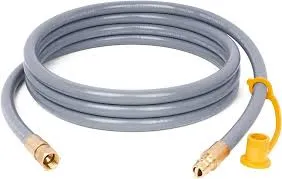335345435
Nov . 04, 2024 17:54 Back to list
Hydraulic Hose Banjo Fittings for Efficient Fluid Connection Solutions
Understanding Hydraulic Hose Banjo Fittings
Hydraulic systems are crucial components in many industrial applications, providing the necessary power to operate machinery efficiently. Among the various components of hydraulic systems, one of the lesser-known yet vital parts is the banjo fitting. Often found in applications where space constraints exist, banjo fittings play a key role in facilitating fluid flow while maintaining a compact design.
What Are Banjo Fittings?
Banjo fittings are specialized connectors typically used in hydraulic systems to create a joint between a hose and a component such as a manifold or a cylinder. They are characterized by their unique “banjo” shape, which consists of a flat circular ring with a hole in the center, allowing for a bolt to hold it securely in place. This design allows for a secure connection that can accommodate fluid flow efficiently without the need for additional bulk.
Design and Features
The simplicity in design is one of the significant advantages of banjo fittings. They are largely made up of three components the banjo fitting itself, a sealing washer, and a bolt. The sealing washer is critical, as it prevents any hydraulic fluid from leaking out, which can be detrimental to machinery operations and safety.
Banjo fittings come in various sizes, materials, and pressure ratings, making them versatile for different hydraulic applications. They are commonly manufactured from durable materials such as steel or aluminum to withstand high pressure and harsh environmental conditions. It’s also essential to choose the right type of seal, such as rubber or copper washers, to ensure a leak-proof connection.
Applications
hydraulic hose banjo fittings

Banjo fittings are widely used across various industries, including automotive, aerospace, and industrial machinery. In automobiles, for instance, they are commonly found in brake systems and fuel lines, where space is limited and a secure connection is essential. In aerospace, they allow for efficient fluid transfer between components without adding unnecessary weight to the aircraft.
In industrial machinery, banjo fittings ensure that hydraulic fluids are delivered to actuators and cylinders, enabling smooth and efficient operation. Their ability to connect hoses at odd angles and in tight spaces makes them particularly valuable in complex hydraulic systems.
Installation and Maintenance
Installing banjo fittings requires attention to detail to ensure a proper seal and to avoid leaks. The installation process typically involves the following steps
1. Preparation Ensure the surfaces where the fittings will be installed are clean and free of debris. 2. Positioning Align the banjo fitting with the hose and the other component, making sure the sealing washer is in place. 3. Securing Insert the bolt through the fitting and washer, tightening it firmly yet carefully to avoid overtightening, which could damage the fitting or strip the threads.
Regular maintenance is also crucial for hydraulic systems using banjo fittings. This includes checking for signs of wear, tear, or leaks. Inspecting the fittings periodically can help identify potential issues before they escalate, ensuring optimal system performance.
Conclusion
In summary, hydraulic hose banjo fittings are a small but significant component of hydraulic systems that promote safe, efficient, and effective fluid transfer. Their compact design, versatility, and reliability make them suitable for various applications, from automobiles to industrial machinery. Understanding their function and proper maintenance can vastly improve the performance of hydraulic systems, enabling them to operate smoothly and safely. As technology progresses and hydraulic systems become more sophisticated, the role of banjo fittings will continue to be integral in ensuring fluid mechanics work seamlessly under pressure.
-
SAE 100 R17 Black Smooth Cover Hydraulic Hose
NewsMar.07,2025
-
SAE 100 R17 Black Smooth Cover Hydraulic Hose
NewsMar.07,2025
-
SAE 100 R17 Black Smooth Cover Hydraulic Hose
NewsMar.07,2025
-
SAE 100 R17 Black Smooth Cover Hydraulic Hose
NewsMar.07,2025
-
SAE 100 R17 Black Smooth Cover Hydraulic Hose
NewsMar.07,2025
-
steel wire braided hydraulic hose
NewsMar.07,2025



